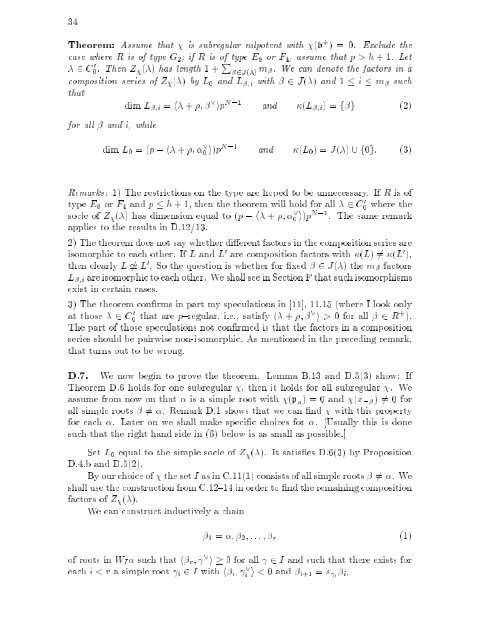subregular nilpotent representations of lie algebras in prime ...
subregular nilpotent representations of lie algebras in prime ...
subregular nilpotent representations of lie algebras in prime ...
You also want an ePaper? Increase the reach of your titles
YUMPU automatically turns print PDFs into web optimized ePapers that Google loves.
34<br />
Theorem: Assume that is <strong>subregular</strong> <strong>nilpotent</strong> with (b + )=0. Exclude the<br />
case where R is <strong>of</strong> type G2; ifR is <strong>of</strong> type E8 or F4, assume that p>h+1. Let<br />
m . We can denote the factors <strong>in</strong> a<br />
2 C 0 0 . Then Z ( ) has length 1+P 2J( )<br />
composition series <strong>of</strong> Z ( ) by L0 and L ;i with<br />
that<br />
2 J( ) and 1 i m such<br />
dim L ;i = h + ; _ N ,1<br />
ip and (L ;i) =f g (2)<br />
for all and i, while<br />
dim L0 =(p ,h + ; _ N ,1<br />
0 i)p<br />
and (L0) =J( ) [f0g: (3)<br />
Remarks: 1) The restrictions on the type are hoped to be unnecessary. IfRis <strong>of</strong><br />
type E8 or F4 and p h + 1, then the theorem will hold for all 2 C 0<br />
0 where the<br />
socle <strong>of</strong> Z ( ) has dimension equal to (p ,h + ; _<br />
0 i)pN ,1 . The same remark<br />
app<strong>lie</strong>s to the results <strong>in</strong> D.12/13.<br />
2) The theorem does not say whether di erent factors <strong>in</strong> the composition series are<br />
isomorphic to each other. If L and L 0 are composition factors with (L) 6= (L 0 ),<br />
then clearly L 6' L 0 . So the question is whether for xed 2 J( )them factors<br />
L ;i are isomorphic to each other. We shall see <strong>in</strong> Section F that such isomorphisms<br />
exist <strong>in</strong> certa<strong>in</strong> cases.<br />
3) The theorem con rms <strong>in</strong> part my speculations <strong>in</strong> [11], 11.15 (where I look only<br />
at those 2 C 0 0 that are p{regular, i.e., satisfy h + ; _ i > 0 for all 2 R + ).<br />
The part <strong>of</strong> those speculations not con rmed is that the factors <strong>in</strong> a composition<br />
series should be pairwise non-isomorphic. As mentioned <strong>in</strong> the preced<strong>in</strong>g remark,<br />
that turns out to be wrong.<br />
D.7. We now beg<strong>in</strong> to prove the theorem. Lemma B.13 and D.5(3) show: If<br />
Theorem D.6 holds for one <strong>subregular</strong> , then it holds for all <strong>subregular</strong> . We<br />
assume from now on that is a simple root with (p )=0and (x, ) 6= 0 for<br />
all simple roots 6= . Remark D.1 shows that we can nd with this property<br />
for each . Later on we shall make speci c choices for . [Usually this is done<br />
such that the right hand side <strong>in</strong> (6) below is as small as possible.]<br />
Set L0 equal to the simple socle <strong>of</strong> Z ( ). It satis es D.6(3) by Proposition<br />
D.4.b and D.5(2).<br />
By our choice <strong>of</strong> the set I as <strong>in</strong> C.11(1) consists <strong>of</strong> all simple roots 6= .We<br />
shall use the construction from C.12{14 <strong>in</strong> order to nd the rema<strong>in</strong><strong>in</strong>g composition<br />
factors <strong>of</strong> Z ( ).<br />
We can construct <strong>in</strong>ductively a cha<strong>in</strong><br />
1 = ; 2;:::; r (1)<br />
<strong>of</strong> roots <strong>in</strong> WI such that h r; _ i 0 for all 2 I and such that there exists for<br />
each i

















